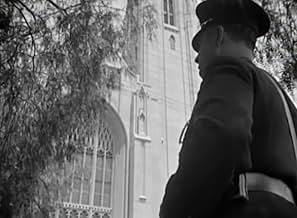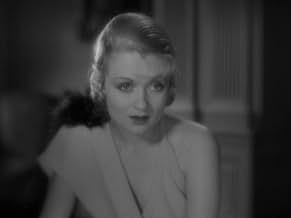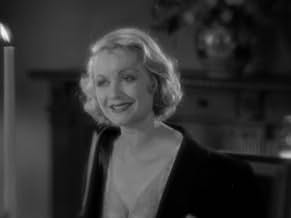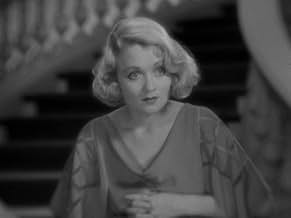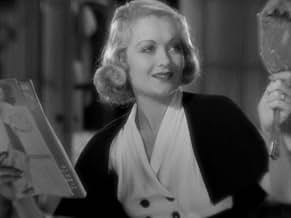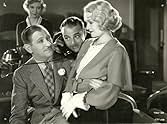VALUTAZIONE IMDb
7,0/10
2856
LA TUA VALUTAZIONE
La carriera di una cameriera sembra prendere il via quando incontra un'amabile e ubriacone regista di Hollywood.La carriera di una cameriera sembra prendere il via quando incontra un'amabile e ubriacone regista di Hollywood.La carriera di una cameriera sembra prendere il via quando incontra un'amabile e ubriacone regista di Hollywood.
- Regia
- Sceneggiatura
- Star
- Candidato a 1 Oscar
- 3 vittorie e 1 candidatura in totale
George Reed
- Undetermined Secondary Role
- (scene tagliate)
Alice Adair
- Undetermined Secondary Role
- (non citato nei titoli originali)
Eddie 'Rochester' Anderson
- James - Max's Butler
- (non citato nei titoli originali)
Sam Armstrong
- Undetermined Secondary Role
- (non citato nei titoli originali)
Zeena Baer
- Secretary to Julius Saxe
- (non citato nei titoli originali)
King Baggot
- Department Head
- (non citato nei titoli originali)
Gerald Barry
- John Reed - an Actor
- (non citato nei titoli originali)
Floyd Bell
- Undetermined Secondary Role
- (non citato nei titoli originali)
Veda Buckland
- Nana - Jackie's Nursemaid
- (non citato nei titoli originali)
Nicholas Caruso
- Chef at Brown Derby
- (non citato nei titoli originali)
Lita Chevret
- Actress Filming on Movie Set
- (non citato nei titoli originali)
Recensioni in evidenza
One of George Cukor's earliest successes before his glory years at MGM was this classic What Price Hollywood. Done at RKO it's the story of three star crossed people and that's literal for one of them.
Constance Bennett plays Mary Evans who is discovered by drunken director Lowell Sherman while working as a waitress at the famous Brown Derby in Hollywood. In 1932 that was the place to be if one wanted to be discovered because all the Hollywood celebrities dined there at one time or another. Including those like Sherman who liked their cuisine strictly liquid and at that time illegal.
You might think that playing a movie star was no stretch for Connie Bennett. But she and her sisters Joan and Barbara were of a distinguished theatrical family with father Richard Bennett in Hollywood himself at that time. She was as far removed from Mary Evans in real life as you can get, still Bennett got deep inside the part.
Sherman might have modeled his character on any number of distinguished Hollywood lushes. He probably took bits from all of them, but his director is uniquely his own, at once self centered, talented, vain and frail.
The third part of this triangle is Neil Hamilton, polo playing scion of a prominent society family who is introduced to Bennett when he smacks her with a polo ball. It was definitely love at first sight, but love between them takes a rocky road.
Hollywood has never been easy on itself. The movie industry figures that the scandals they've had are all too public so honesty is probably the best policy. In the sound era What Price Hollywood is one of the first of a long line of critical examination of the movie industry that also includes The Big Knife, The Bad And The Beautiful, Callaway Went Thataway and Two Weeks In Another Town. And of course we can't forget A Star Is Born in its original and remakes.
What Price Hollywood got an Oscar nomination for Best Original Screenplay. As its done before the Code, it holds up well today as a mark of distinguished and mature film making.
Constance Bennett plays Mary Evans who is discovered by drunken director Lowell Sherman while working as a waitress at the famous Brown Derby in Hollywood. In 1932 that was the place to be if one wanted to be discovered because all the Hollywood celebrities dined there at one time or another. Including those like Sherman who liked their cuisine strictly liquid and at that time illegal.
You might think that playing a movie star was no stretch for Connie Bennett. But she and her sisters Joan and Barbara were of a distinguished theatrical family with father Richard Bennett in Hollywood himself at that time. She was as far removed from Mary Evans in real life as you can get, still Bennett got deep inside the part.
Sherman might have modeled his character on any number of distinguished Hollywood lushes. He probably took bits from all of them, but his director is uniquely his own, at once self centered, talented, vain and frail.
The third part of this triangle is Neil Hamilton, polo playing scion of a prominent society family who is introduced to Bennett when he smacks her with a polo ball. It was definitely love at first sight, but love between them takes a rocky road.
Hollywood has never been easy on itself. The movie industry figures that the scandals they've had are all too public so honesty is probably the best policy. In the sound era What Price Hollywood is one of the first of a long line of critical examination of the movie industry that also includes The Big Knife, The Bad And The Beautiful, Callaway Went Thataway and Two Weeks In Another Town. And of course we can't forget A Star Is Born in its original and remakes.
What Price Hollywood got an Oscar nomination for Best Original Screenplay. As its done before the Code, it holds up well today as a mark of distinguished and mature film making.
What that lady needed was a good script and a fine director. She had both in "Our Betters." And she had it here. And this one will break your heart.
The on-the-set ambiance is very plausible. Lowell Sherman is excellent as the tippling director who discovers waitress Bennett and becomes a heavier drinker. Gregory Ratoff is superb as the initially brusque but increasingly sympathetic producer Saxe.
Conusance Bennett is likable as the ambitious waitress. She gets us to smile as she starts out as a crummy actress but works hard at it. And she is directed to a superb performance when things for Sherman, her, and her husband Neil Hamilton get tough.
The on-the-set ambiance is very plausible. Lowell Sherman is excellent as the tippling director who discovers waitress Bennett and becomes a heavier drinker. Gregory Ratoff is superb as the initially brusque but increasingly sympathetic producer Saxe.
Conusance Bennett is likable as the ambitious waitress. She gets us to smile as she starts out as a crummy actress but works hard at it. And she is directed to a superb performance when things for Sherman, her, and her husband Neil Hamilton get tough.
"What Price Hollywood?" is one of my favorite films of the 1930s. With loads of drama, glamour to spare, and some romance too, this movie is one of the best behind-the-scenes looks at the old Hollywood studio system that was ever made. Constance Bennett, looking her radiant best, plays the lead role with finesse. Lowell Sherman also turns in a powerful performance as a washed-up director. This movie was the basis for "A Star is Born." All in all, one great film.
It's fun to compare "What Price Hollywood," made in 1932, to the more familiar 1937 version of "A Star is Born" (as well as its two later remakes). An important historic event intervened between the two: the Hays Code became rigidly enforced in 1934. The 1932 version is much spicier. Mary, the unknown knockout in in the 1932 version, is a saucy waitress at the legendary Brown Derby restaurant trying to catch the eye of a movie big shot. She's pretty sophisticated and, you believe, would happily do whatever is required to land an acting job. She readily allows herself to be picked up and taken to a premiere by a famous (but fading) director, which launches her great career. In the 1937 version, Esther, the ingenue, is straight off the farm and comes to Hollywood without a clue about the movie biz. She's a goody-two-shoes who would be shocked about what it usually takes to break into the biz. She catches the eye of a famous (but fading and highly alcoholic) actor when she waitresses at a party.
There is one major plot difference: in the 1932 version, Mary marries a rich polo playing socialite who divorces her (while she's pregnant) because he is fed up with movie people. This is highly realistic--movie stars had terrible marital problems. In the 1937 version, Esther marries the actor who was her mentor and is sucked into his hopeless downward spiral. Divorce is a perfectly acceptable solution to marital problems in 1932 but, under the constraints of the Code, was out of the question in 1937.
Both films are well worth seeing. They're loaded with insights about Hollywood and filmmaking (both the creative and the business end), the rapacious movie press, and the fans--an insatiable monster that devours the object of its affection. The declining fortunes of the director (in "What Price Hollywood") and the actor (in "A Star is Born") are quite fascinating. But of the two--the 1932 version is a lot more fun.
There is one major plot difference: in the 1932 version, Mary marries a rich polo playing socialite who divorces her (while she's pregnant) because he is fed up with movie people. This is highly realistic--movie stars had terrible marital problems. In the 1937 version, Esther marries the actor who was her mentor and is sucked into his hopeless downward spiral. Divorce is a perfectly acceptable solution to marital problems in 1932 but, under the constraints of the Code, was out of the question in 1937.
Both films are well worth seeing. They're loaded with insights about Hollywood and filmmaking (both the creative and the business end), the rapacious movie press, and the fans--an insatiable monster that devours the object of its affection. The declining fortunes of the director (in "What Price Hollywood") and the actor (in "A Star is Born") are quite fascinating. But of the two--the 1932 version is a lot more fun.
The direction of George Cukor for this film is excellent. The three lead characters have three charming, yet completely different personalities. The great talent of George Cukor doesn't allow the energy of any of his characters to wane. The performance of Lowell Sherman only adds to the wonderful script, and only the innocence of Constance Bennett is able to carry the role of an aspiring starlet that makes it so believable. Neil Hamilton (later to play the 'Commissioner' on the "Batman" TV series of the mid-1960's) is excellent as the 'love interest'. But it is Lowell Sherman who steals nearly every scene in the wonderful jewel of a film. The story of this film is like many real-life stories of almost everyone who has ever worked in Hollywood - either in front of the camera or behind the lens. To me, this IS the original "A Star is Born", and that is why it is one of my favorite films of all time. From the appearance of Eddie "Rochester" Anderson to the Brown Derby to the scenes of the night life of the early days of Hollywood, "What Price Hollywood?" will always be a memorable film for me.
Lo sapevi?
- QuizThis film bears such a striking resemblance to È nata una stella (1937) that it is often considered "the original version" of that often remade classic. In fact, David O. Selznick, who produced both this film and Star is Born, was threatened with a lawsuit by this film's writers, claiming plagiarism.
- BlooperWhen the screen shows a newspaper gossip column, part of an item relating a joke about a Jewish boy and a bird can be seen. Several months later, another gossip column shows the identical item.
- Curiosità sui creditiThere is a "by" credit to Gene Fowler and Rowland Brown after the title shows, but there is also a "screenplay by" credit to Jane Murfin and Ben Markson, without leaving any clear explanation or context as to what "by" actually means. But the reality was that Fowler and Brown wrote the real screenplay, with Murfin and Markson providing the continuity.
- ConnessioniFeatured in David O. Selznick: 'Your New Producer' (1935)
- Colonne sonoreThree Little Words
(1930) (uncredited)
Music by Harry Ruby
Part of a medley played during the opening credits
I più visti
Accedi per valutare e creare un elenco di titoli salvati per ottenere consigli personalizzati
- How long is What Price Hollywood??Powered by Alexa
Dettagli
- Data di uscita
- Paese di origine
- Lingue
- Celebre anche come
- What Price Hollywood?
- Luoghi delle riprese
- Azienda produttrice
- Vedi altri crediti dell’azienda su IMDbPro
Botteghino
- Budget
- 411.676 USD (previsto)
- Tempo di esecuzione
- 1h 28min(88 min)
- Colore
- Proporzioni
- 1.37 : 1
Contribuisci a questa pagina
Suggerisci una modifica o aggiungi i contenuti mancanti


